Andreas Christensen perhaps did not initially receive the same vociferous praise usually credited to Chelsea’s proud and illustrious list of Cobham graduates, struggling to assert himself in previous Chelsea sides and seeing the likes of Kurt Zouma start ahead of him. But the Denmark international has now firmly established himself as a key player for Thomas Tuchel’s outfit, encapsulated by his unflappable Champions League final performance last summer after replacing the injured Thiago Silva in the first half.
The notion of Christensen, still relatively young at 25, replacing Silva in May’s final could have been symbolic of a changing of the guard in Chelsea’s defence. However, whether it be due to off-field issues or otherwise, the Dane finds himself on the brink of an imminent free transfer to Xavi’s revitalised Barcelona side. Christensen’s ball-playing and progressive skills make him a seemingly perfect fit for the Catalans, who likewise advocate possessional autonomy for their centre-backs.
This scout report and tactical analysis will examine Christensen’s abilities and assess why Barcelona may be picking up one of the most undervalued defenders in world football.
Position
Christensen primarily operates as a centre-back but offers positional fluidity and has fulfilled a more conventional right-back role when called upon this season. Chelsea are arguably at their most defensively robust when Christensen assumes the RCB role in a back three, with Thiago Silva and Antonio Rüdiger completing a formidable defensive trio.
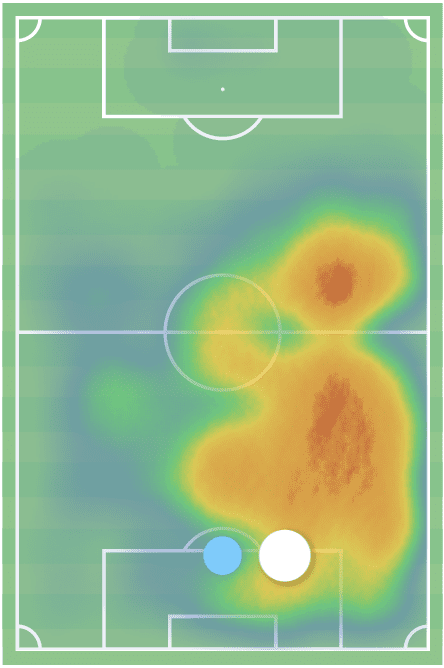
Being able to play in these slightly wider positions requires a clear, tight connection with teammates and an element of press resistance. Not being composed in possession when forced deep and wide subsequently puts the team in an awkward situation where they are unable to effectively build-up play from the back. From a tactical perspective, being able to efficiently recycle possession in wide and deep areas draws the opposition block vertically and horizontally, separating connections in defensive lines which could potentially be exposed. It thus constitutes an important part of the field in modern-day games.
Data and analysis – defensive contribution
The use of data in the recruitment process is always developing and now assumes a crucial role in the definition of player strengths and weaknesses. This analysis will primarily use Christensen’s defensive and possession-based metrics to quantify how much of an asset he is to this current Chelsea side. As Christensen predominantly operates as a centre-back, it is of the essence to begin with his defensive statistics.
Christensen is widely perceived as a proactive rather than a reactive defender; pre-empting and successively eradicating danger whilst defending on the front foot, as opposed to constantly having to make recovery runs and tackles to deny the opponent the opportunity to progress the ball.

The figures above exemplify this notion; Christensen’s average of 1.14 tackles per 90 place him in the bottom 23rd percentile out of other centre-backs in Europe. Conversely, his average of 2.96 interceptions per 90 place him in the top 7th percentile in the same parameters.
The disparity between these two figures illustrates Christensen’s defensive approach; being able to predict attacking combinations and negate passing patterns, rather than conceding ball control in tactically dangerous areas and having to commit to challenges to try and regain possession.
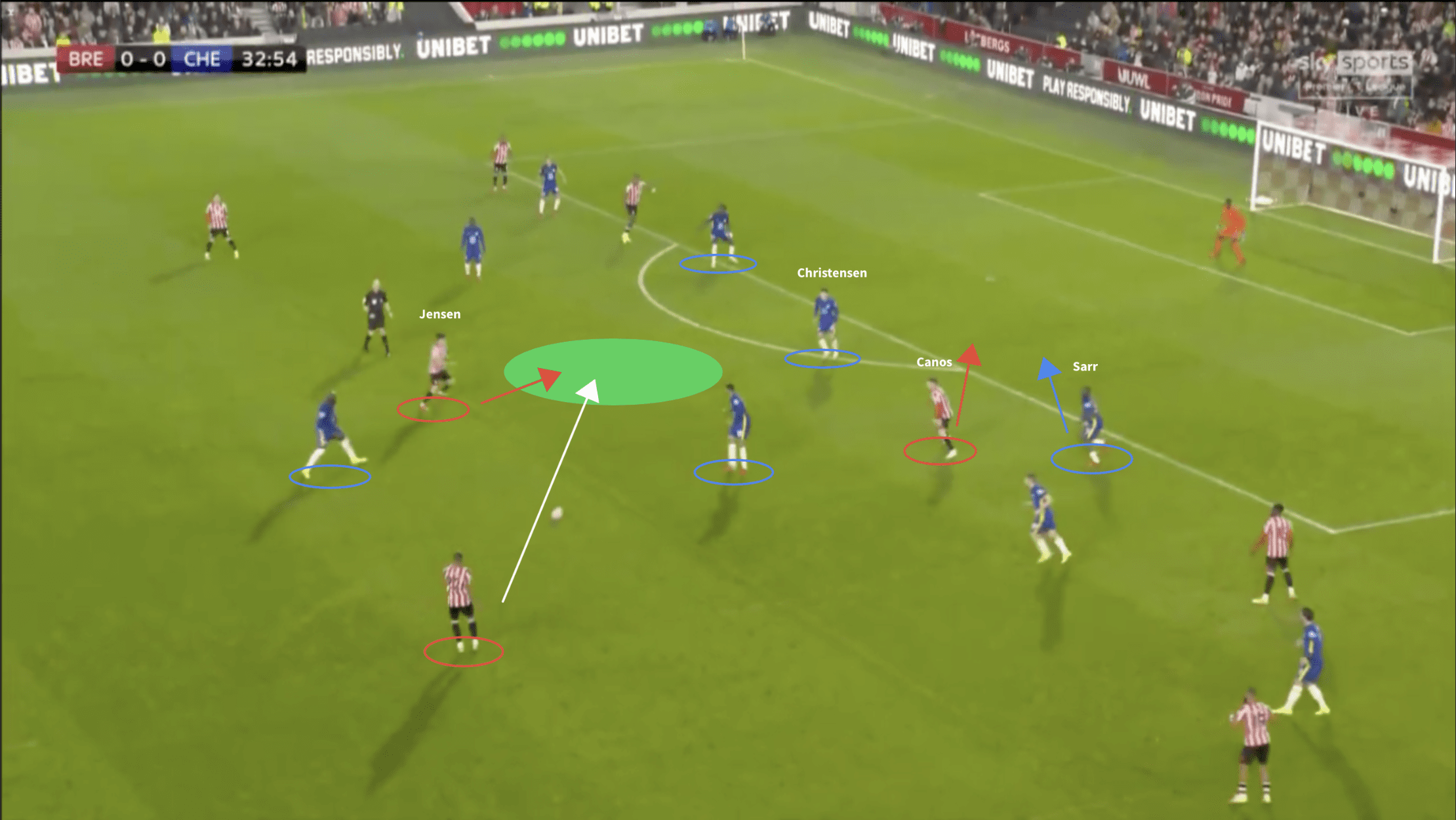
Here, Chelsea’s opponents Brentford are easily able to transcend an uncompact midfield block and progress the ball into the assist zone. Christensen, assuming the central role in a back three, now faces a dilemma; either engage with Jensen and leave Canos to make a potentially hazardous blind-side run into the unmarked space, or follow the run and allow Jensen control of a potent position on the pitch.
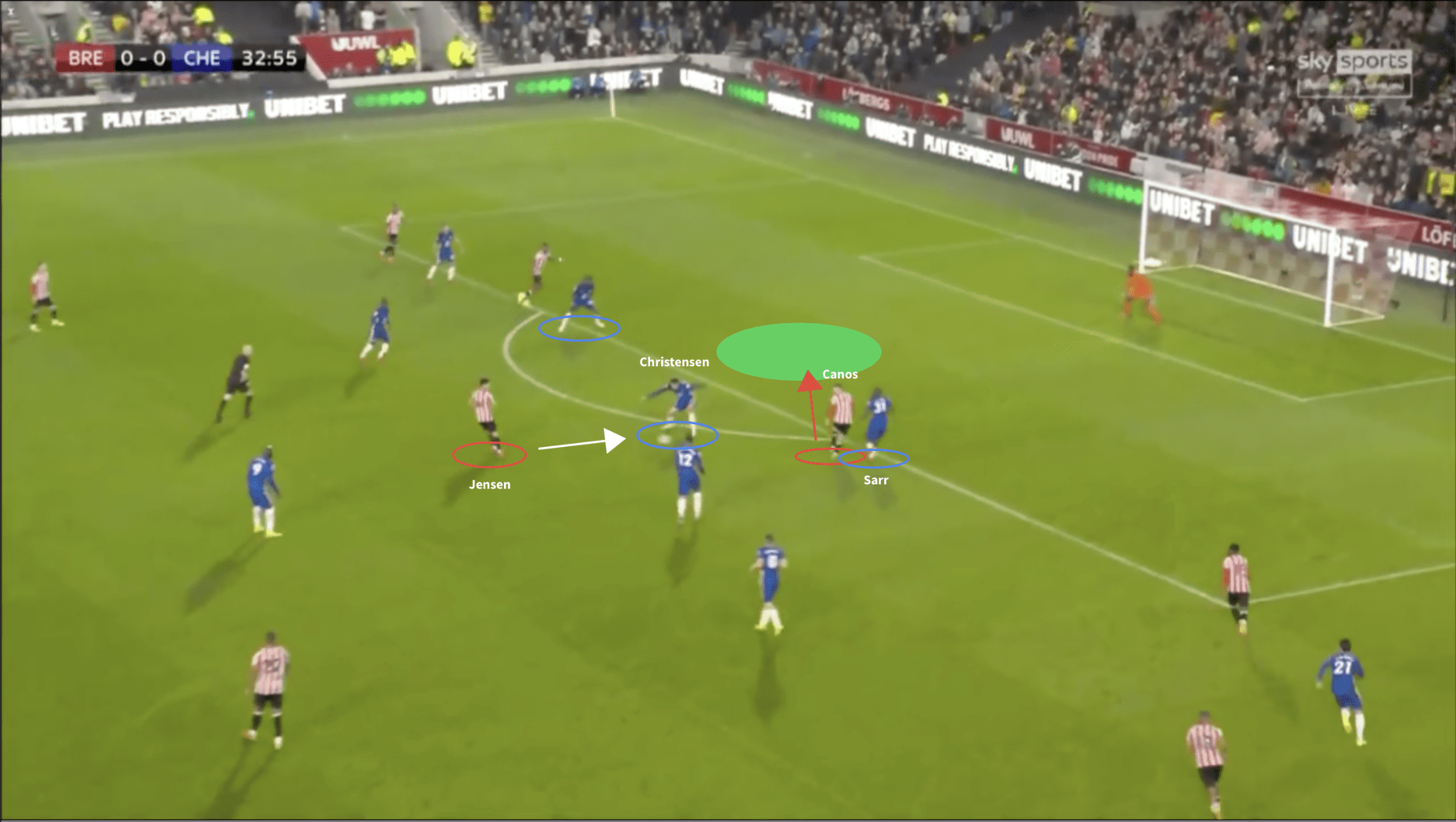
Christensen wisely does neither; he holds his position on the edge of the area and predicts a first-time pass from Jensen, intercepting possession in an important phase of the game as the LCB (Sarr) was unlikely to match Canos’ run. Equally, if Christensen had committed to engage with Jensen, he’d have reduced his reaction time to intercept the pass and furthermore opened up more space for Canos to run into. Having this degree of spatial control and awareness exemplifies a proactive and intellectual approach to defending.
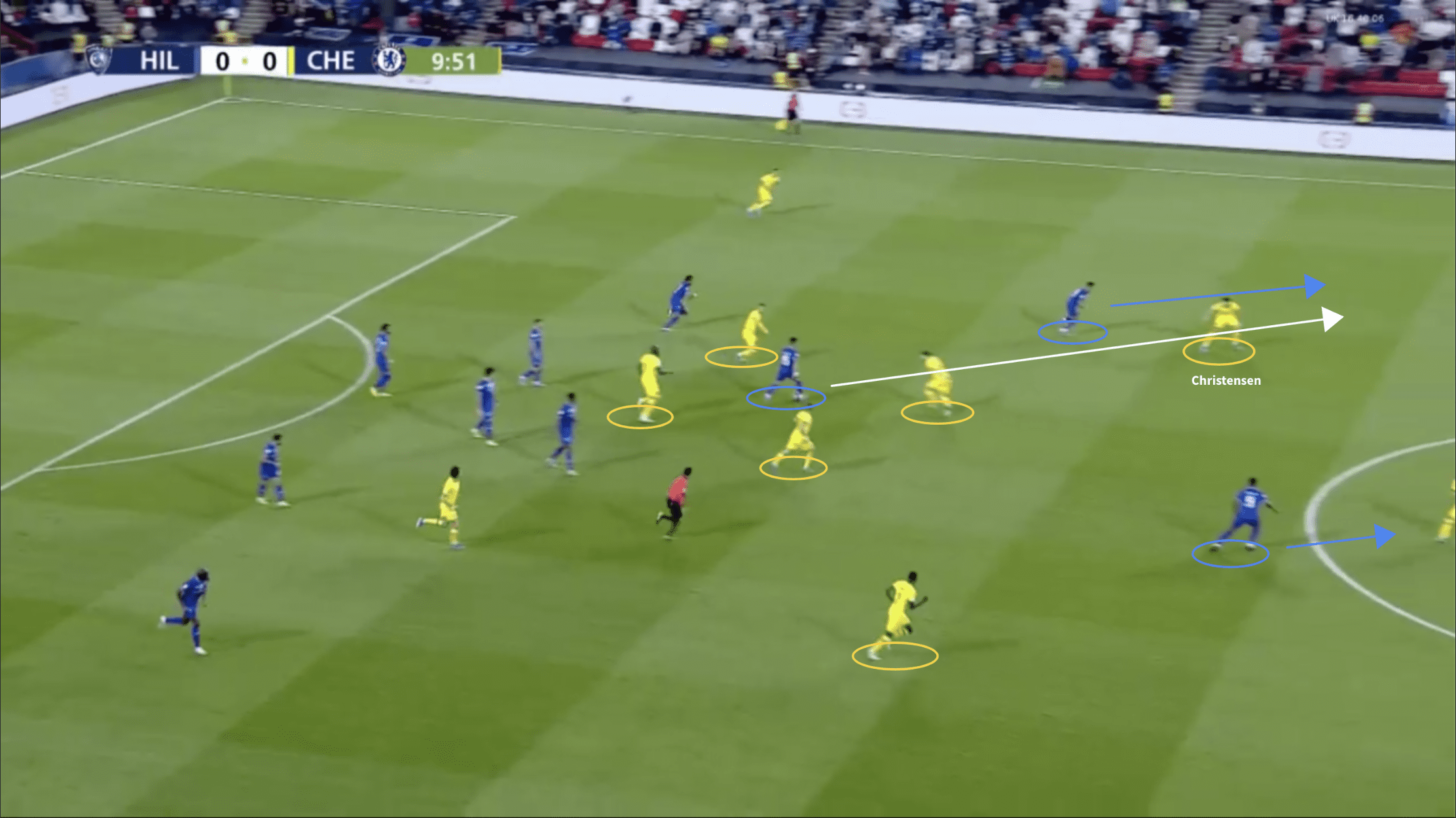
In this example, Chelsea have just suffered a negative transition and Christensen is potentially exposed in the RCB role because of his side’s high defensive line. A ball over the top would see the opposition break Chelsea’s line of defence.
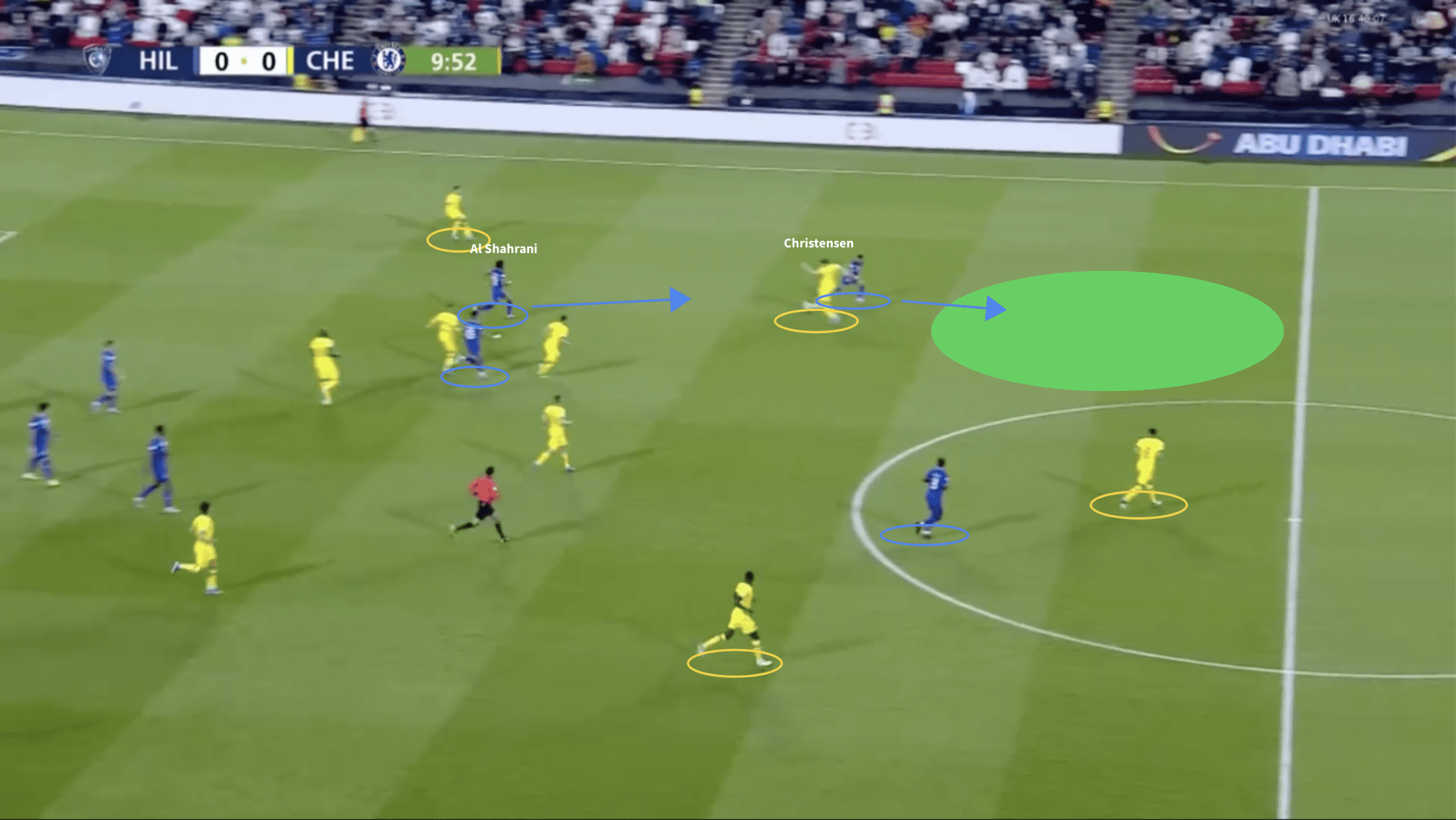
Christensen riskily chooses to engage with the pass, conceding copious amounts of space behind him. However, his assessment of the situation is perfect; his adjustment to accommodate the conditions of this phase sees the Dane regain possession for Chelsea, but he is now under immediate pressure from the ball player (Al Shahrani).
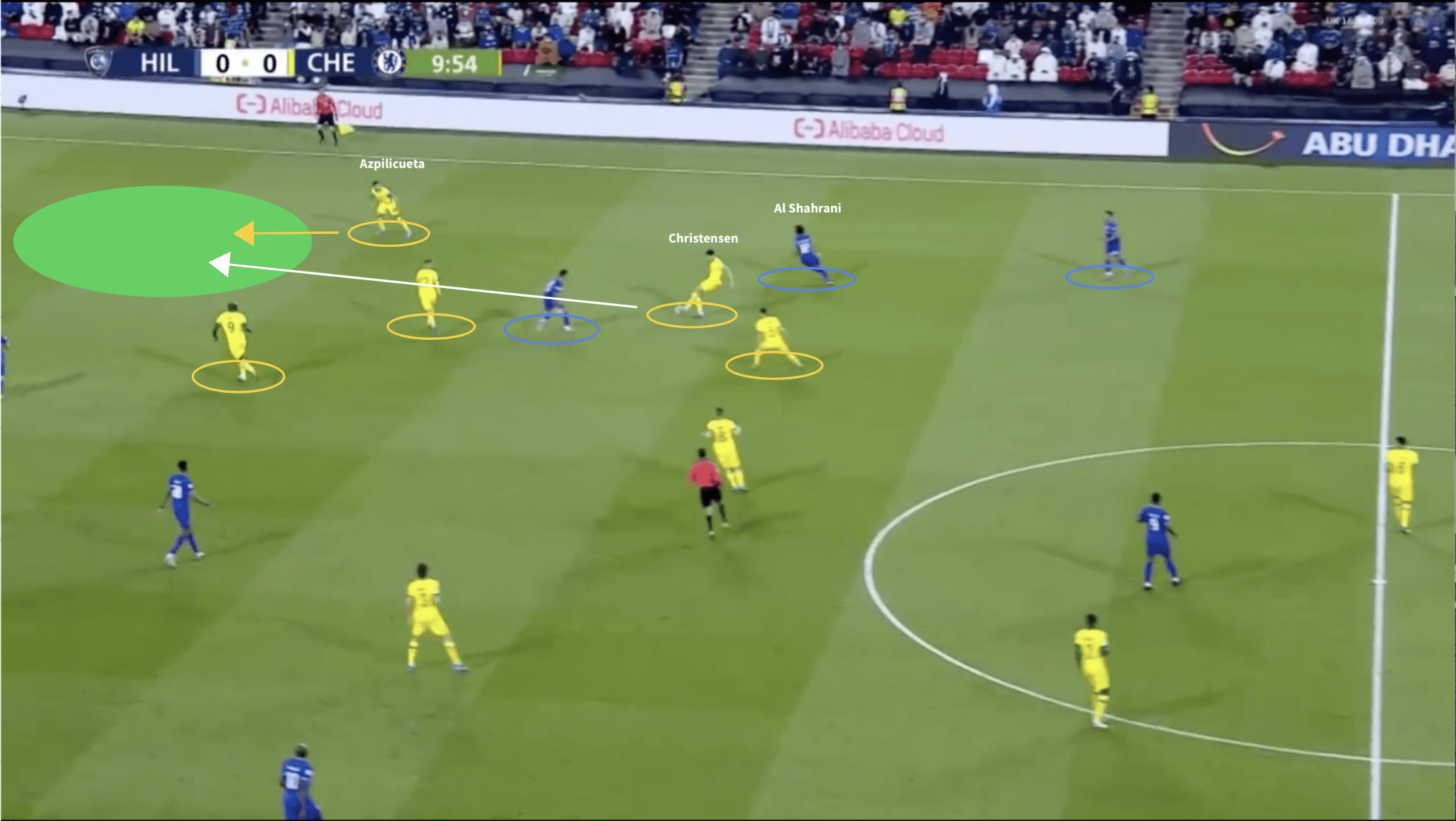
Christensen uses his technical elegance to evade the challenge of Al Sahrani, preventing any chance of an effective opposition counter-press. His ability to transcend this pressure additionally opens a progressive passing option to Azpilicueta, driving Chelsea into a dangerous area of the pitch.
Crucially, Christensen exhibits his capability to turn a negative transition into regaining control. A mistimed defensive action would have made the situation worse, but Christensen’s ability to adjust to the conditions of the turnover and calculate the direction of the pass allowed Chelsea to reassert authority in this sub-phase. Less proactive defenders arguably would have been content with making a recovery run and attempting to neutralise a 1v1 situation close to their own penalty box. It is the hallmark of intelligent and front-footed defending which strongly characterises Christensen’s game.
Data and analysis – attacking and progressive contribution
What however sets aside Christensen from other elite-level centre backs, which will undoubtedly draw the most attention from Barcelona, is his ability to progressively build-up play from the back and dictate possession. Considering how Xavi’s Barcelona like to progress the ball; namely building from defence and drawing in opponents to manipulate their defensive structure, Christensen’s talent on the ball and his high level of attacking knowledge constitutes a fundamental attribute to his skillset that would accompany him perfectly should he move to Spain.
As such, the following data displays Christensen’s passing metrics in comparison to other Premier League centre-backs this season, starting with forward passes.
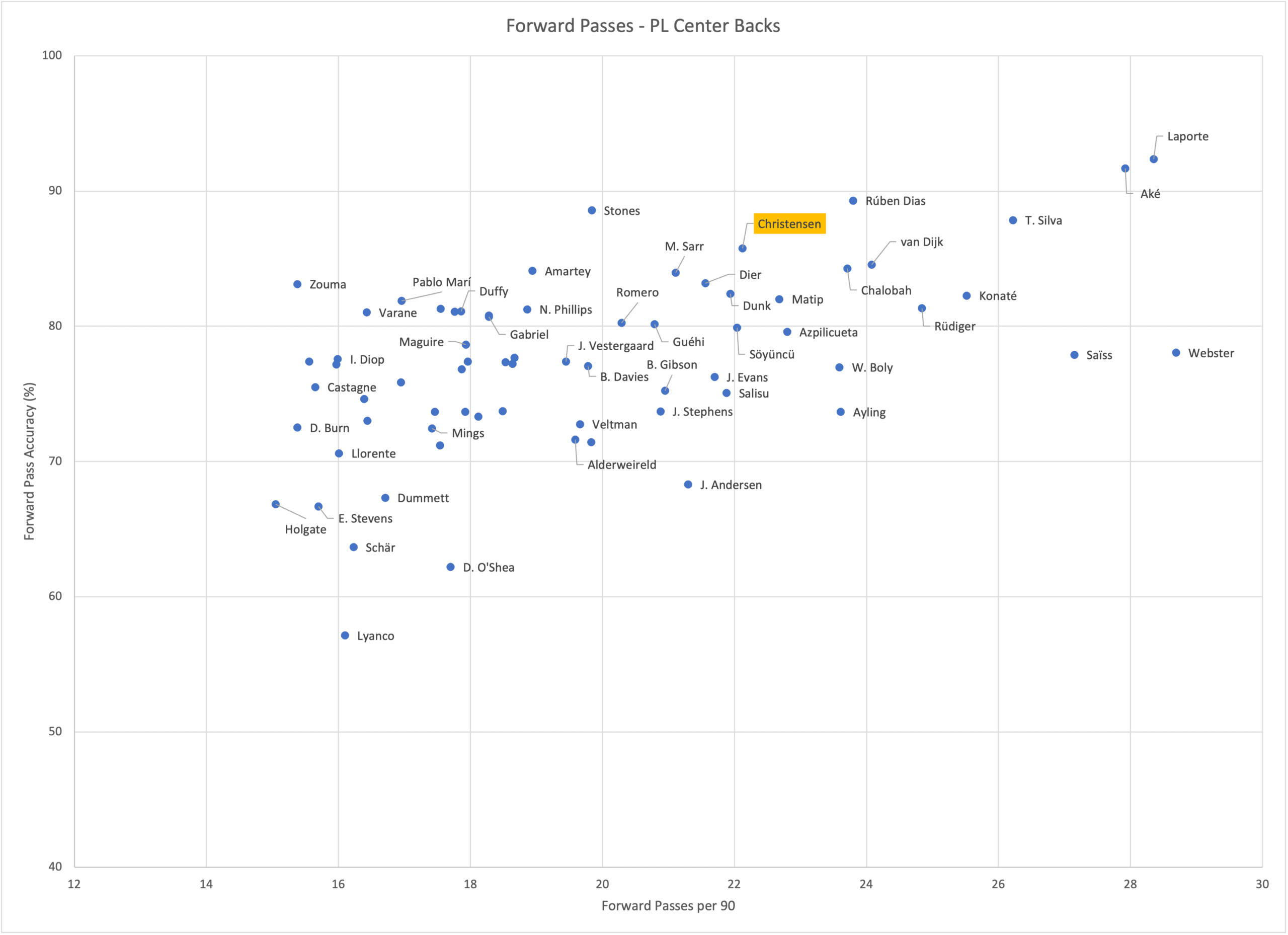
Christensen’s average of 22.12 forward passes per 90, with an accuracy of 85.75%, places him comfortably above the league average of 16.97 forward passes per 90 at an accuracy of 75.48%.
What Christensen really excels in with regards to his passing metrics, however, is his efficiency and accuracy in passing into offensive areas, as illustrated below.
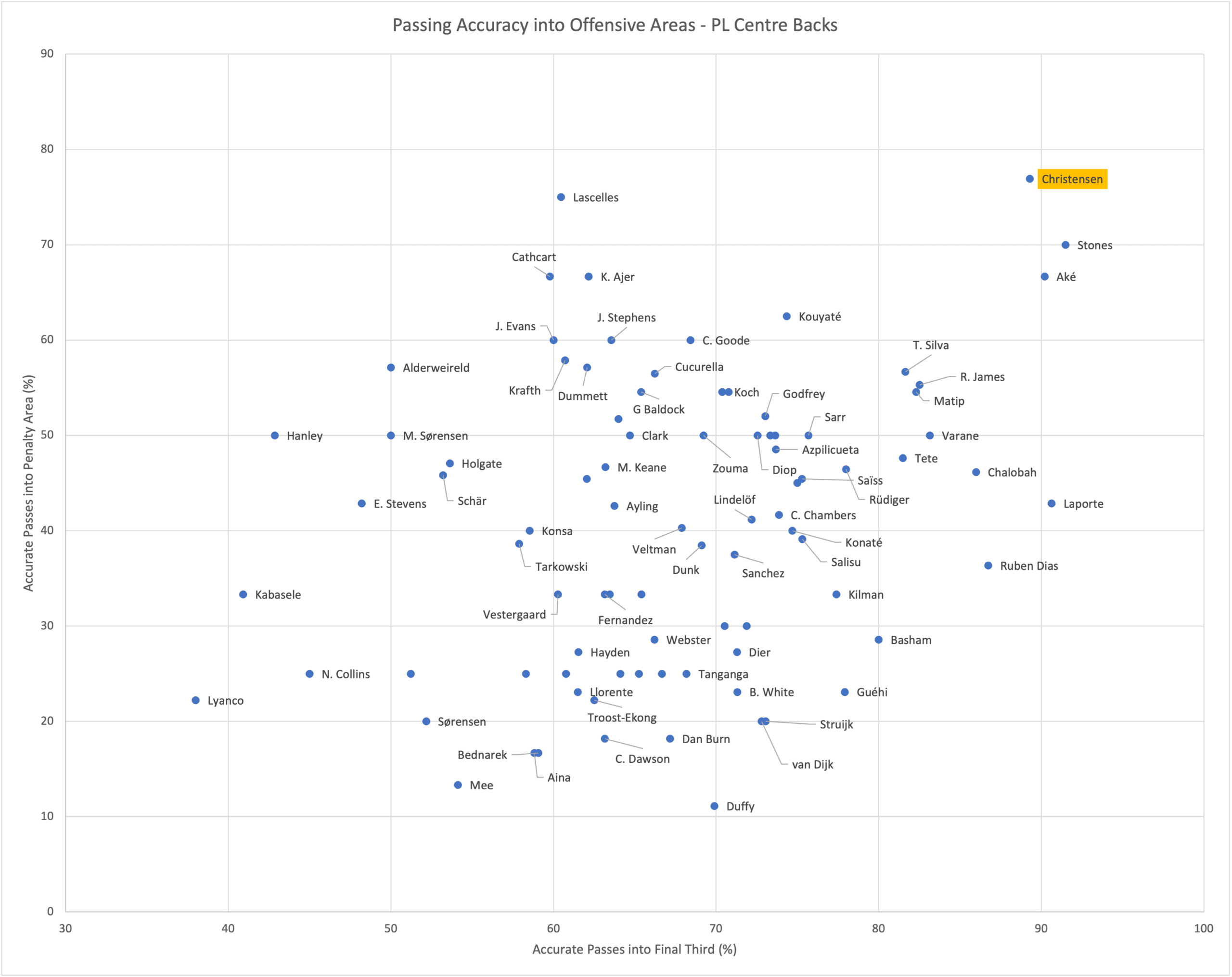
Christensen’s 76.92% passing accuracy into the penalty area is the highest out of all Premier League centre-backs this season, whilst his 89.29% passing accuracy into the final third places him 4th in the list. This demonstrates his competence and effectiveness in starting attacks from the back, making him a consistent and dangerous threat in possession.
When considering the autonomy Xavi gives his centre-backs in possession, namely attracting high blocks and being able to execute direct, vertical passes to the striker, Christensen’s outstanding passing accuracy makes him a worthy candidate to fulfil this function.
Christensen’s passing distinction is further exemplified by his progressive passing figures – arguably the most important aspect in a modern-day centre-back’s attacking arsenal. The below metrics also incorporate Christensen’s progressive carries.
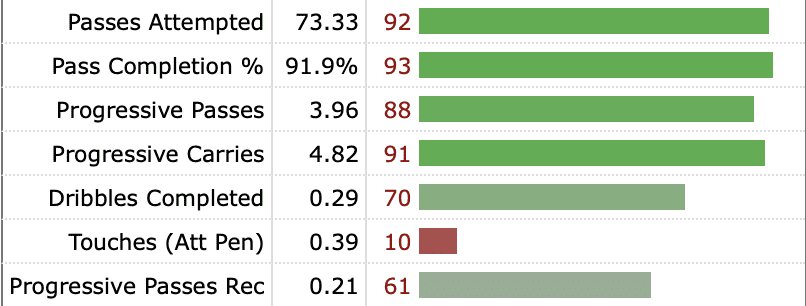
Christensen’s average of 3.96 progressive passes and 4.82 progressive carries per 90 place him in the top 12th and 9th percentile respectively out of other centre-backs in Europe, displaying his merit in being able to break the first line of pressure and advance the ball from static possession. Furthermore, his ability to drive forward and force the issue assists in disrupting the opposition shape, helping forge attacking situations from seemingly innocuous positions.
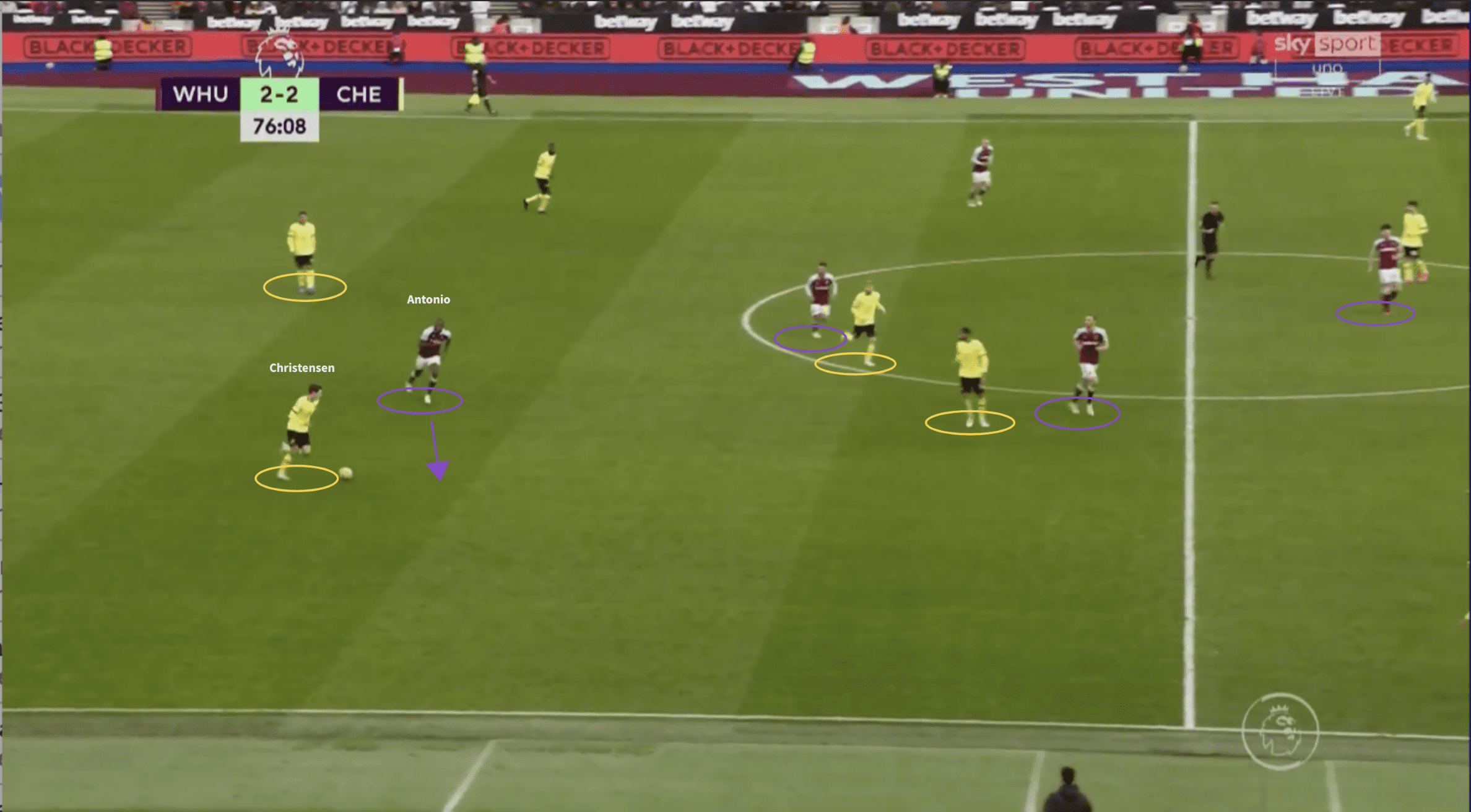
Here, Christensen receives the ball in his own half and under pressure from Antonio, whose characteristic tenacity and perseverance in pressing would potentially intimidate less comfortable defenders in possession.
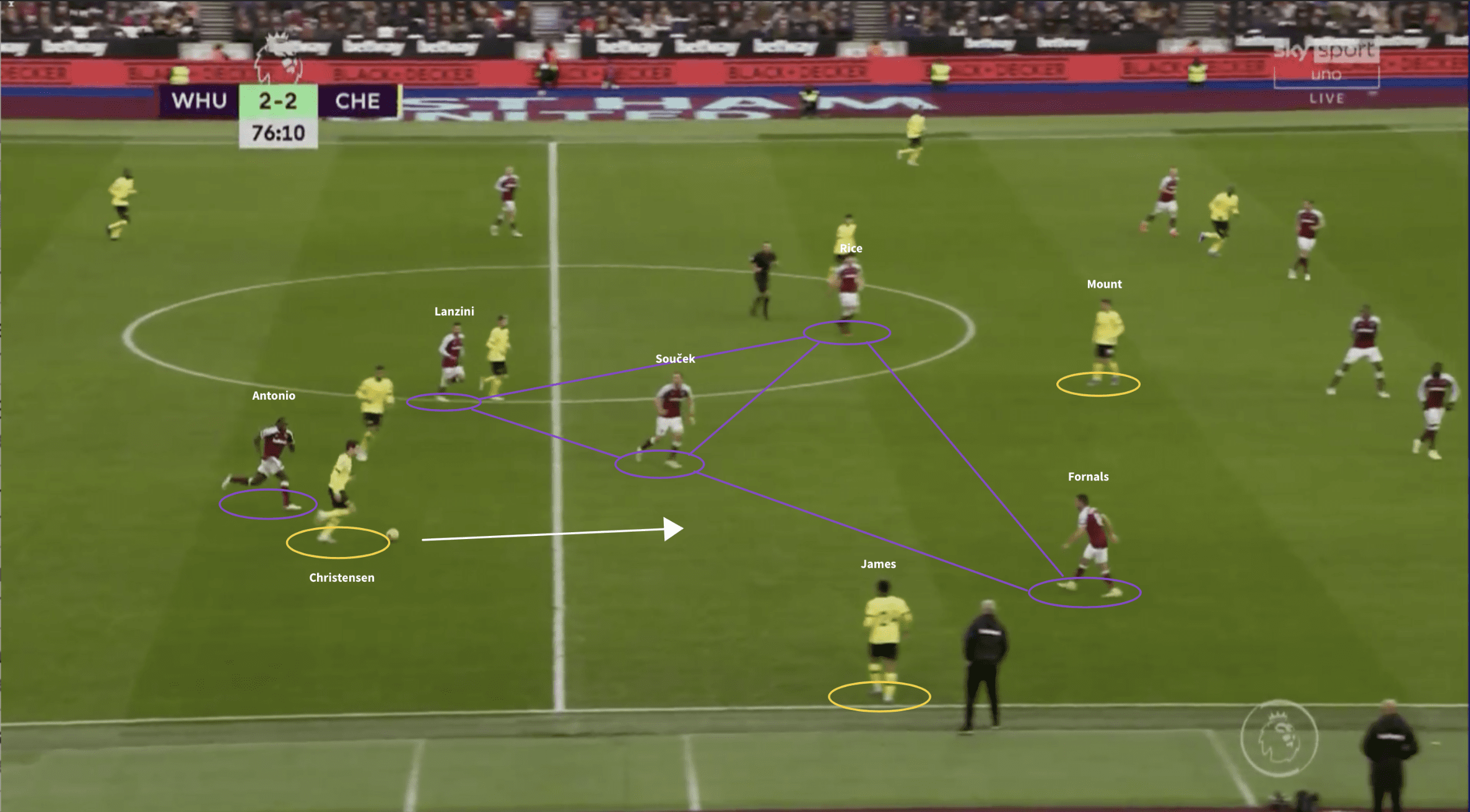
Christensen is no slouch, but certainly is not usually renowned for his pace or physical presence. However, he here carries the ball past Antonio into the midfield third, only to be met by a typically compact West Ham mid-block.
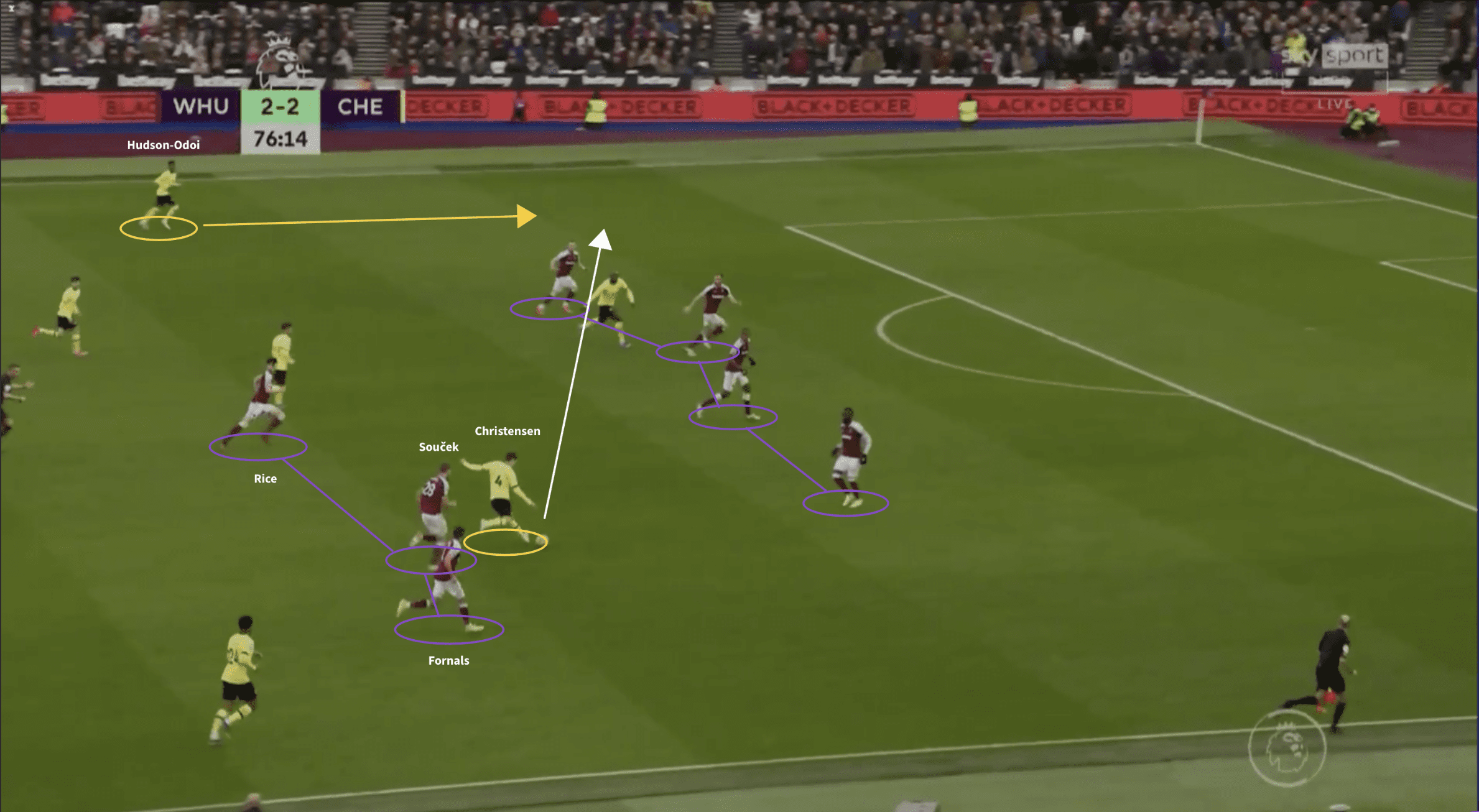
Christensen skilfully skips past the challenges of Fornals and Souček, single-handily breaking the first line of pressure and finding spaces between the lines. Christensen then seamlessly picks out a cross-field pass to Hudson-Odoi on the left, isolating the opposition RB in a 1v1 situation.
By drawing in opposition players and then beating them, this helps ensure numerical advantage is attained in build-up play and completely disrupts the opponent’s defensive shape. As exemplified above, it further increases the space for attacking players to operate with and create chances.
In revisiting Christensen’s progressive passing metrics, the graph below illustrates these numbers in comparison to other Premier League centre-backs this season.
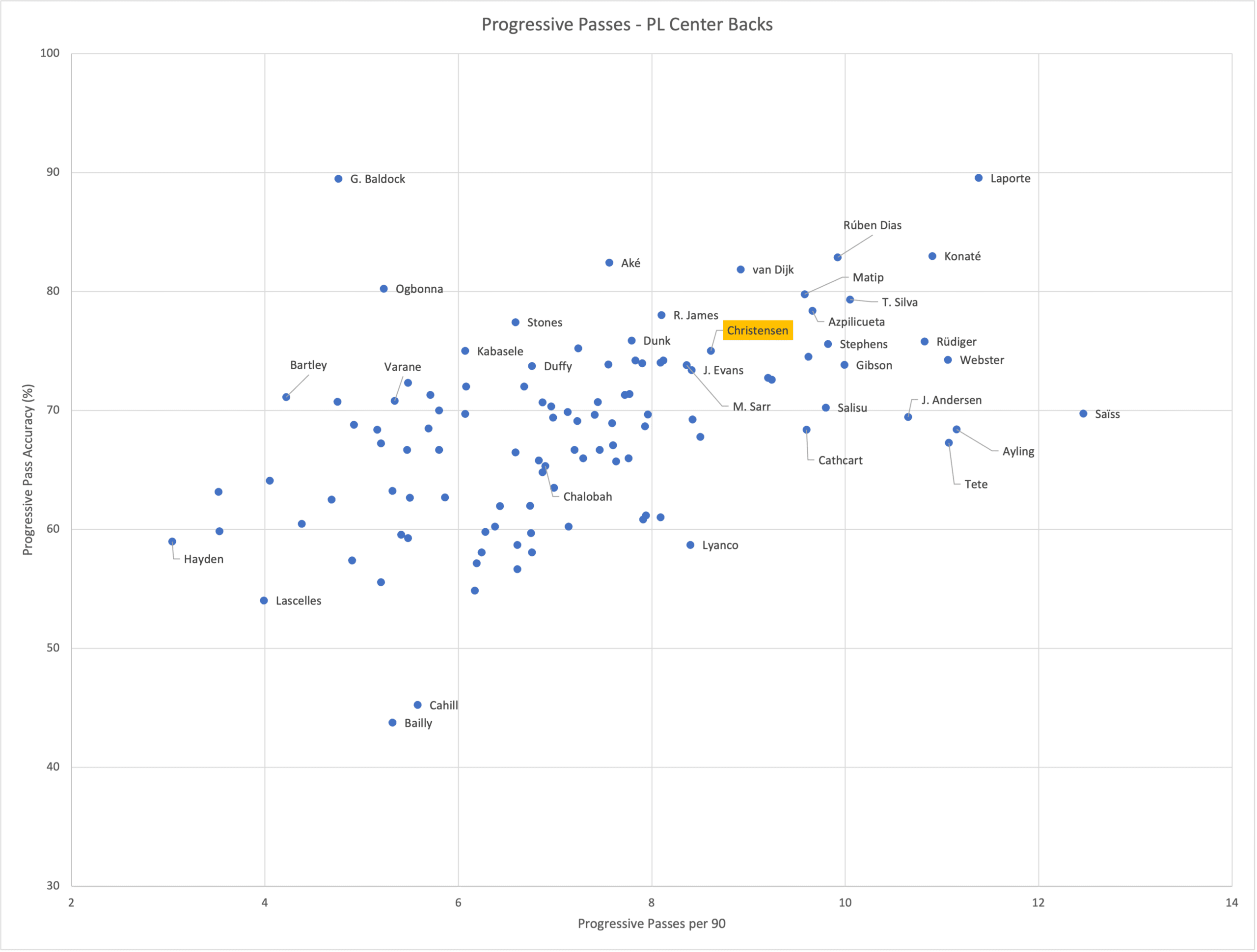
Christensen’s average of 8.61 progressive passes per 90 at an accuracy of 75% again comfortably places him above the league average of 7.18 and 68.21%. These metrics display an ease with exploiting forward passing lanes – a crucial element to manipulating the opponent’s defensive system and creating chances.
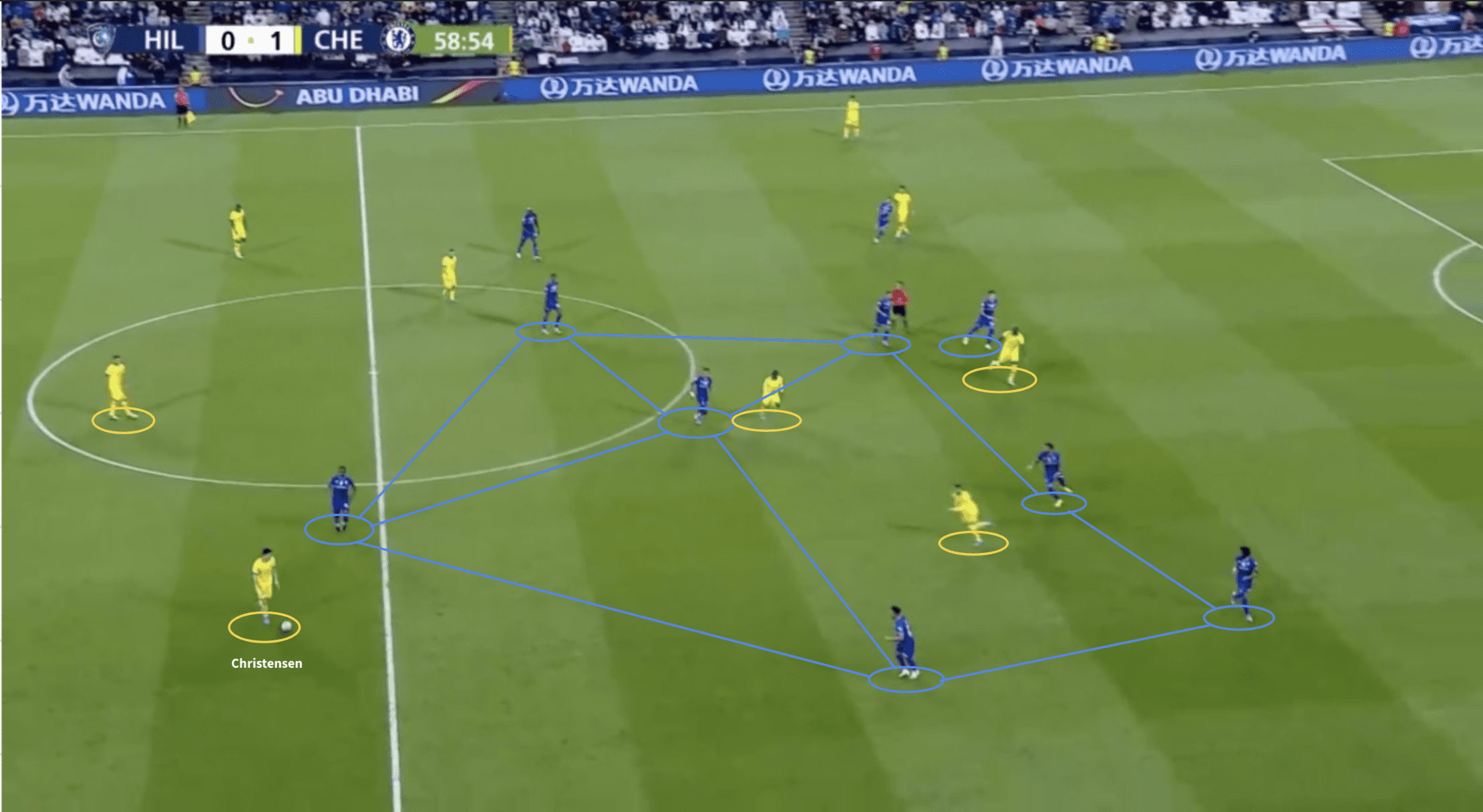
Here, Christensen again receives the ball in his own half and encounters a dense opposition midfield setup. The easy option would be to play a horizontal pass to Azpilicueta (out of frame) in the RWB position and circulate possession. However, Christensen is attentive to developments and chooses a better alternative.
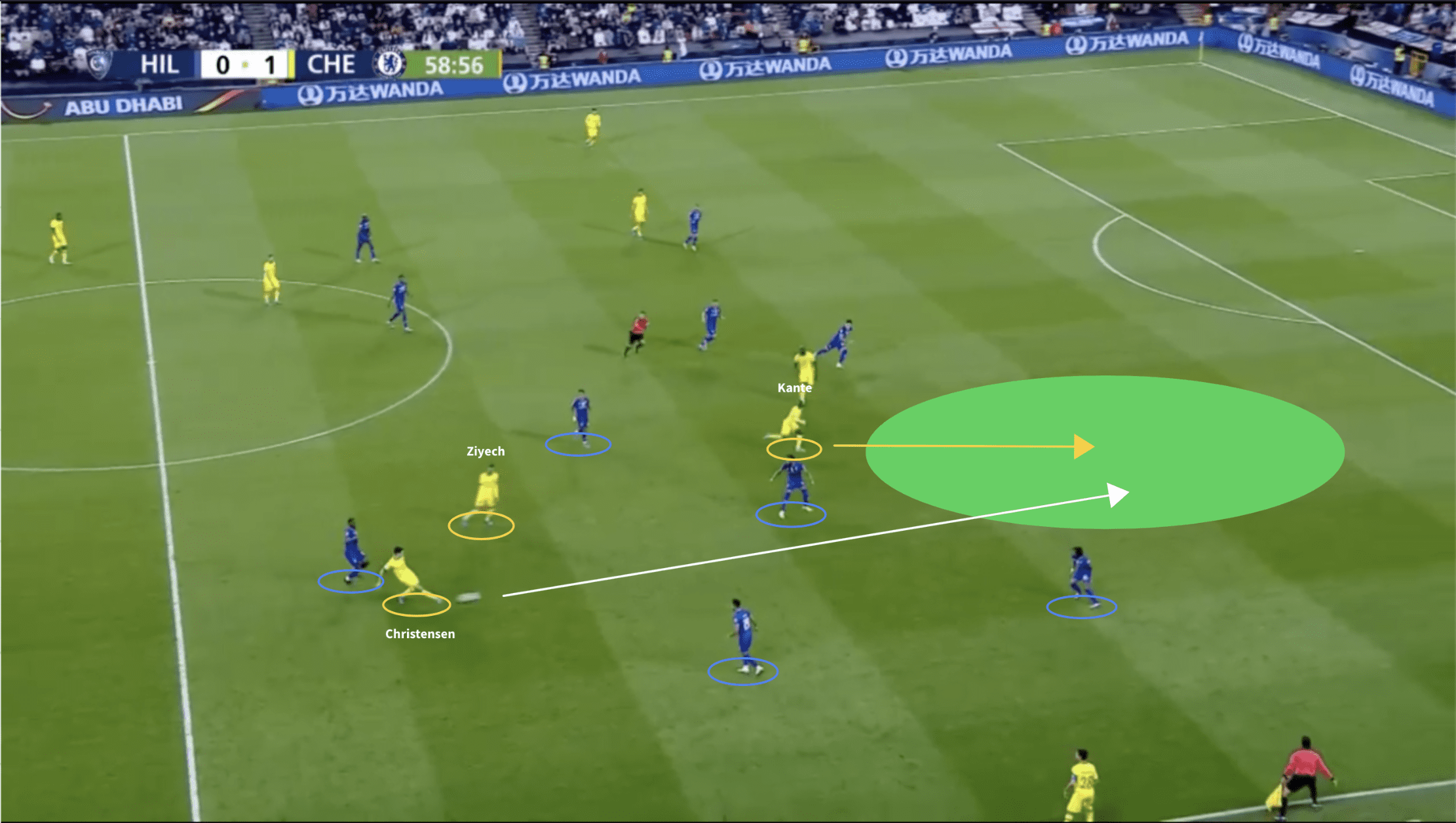
Christensen recognises how Ziyech’s movement has dragged the opposition centre-back out of position, so drives further into the midfield third. He then spots Kante making a forward run into the fashioned space and picks a pass into the opposition penalty area. Christensen’s aforementioned accuracy with these types of passes makes it a straightforward task for him.
Christensen here displayed tactical awareness of the developments in front of him, effectively engaging with seemingly well-drilled and purposeful off-ball movements from his teammates to create a scoring opportunity. Staying attentive to these developments, rather than merely looking to recycle possession, conveys an element of tactical cognisance that typifies Christensen’s style on the ball and playmaking ability.
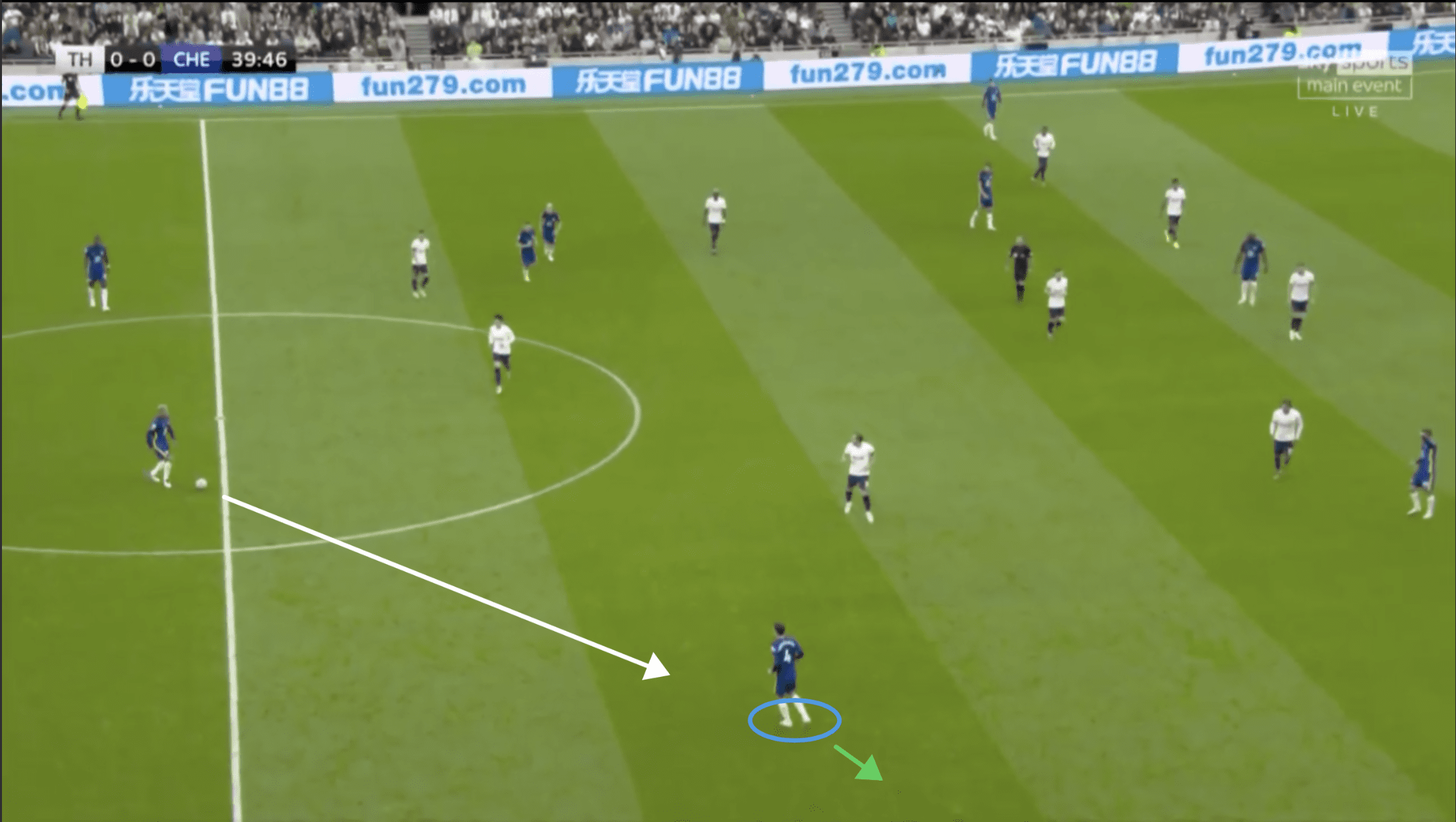
In this final example, Christensen drops deep and wide to provide a diagonal passing option for Thiago Silva, which in turn pulls the opposition block both vertically and horizontally. It also increases the space for him to operate with.
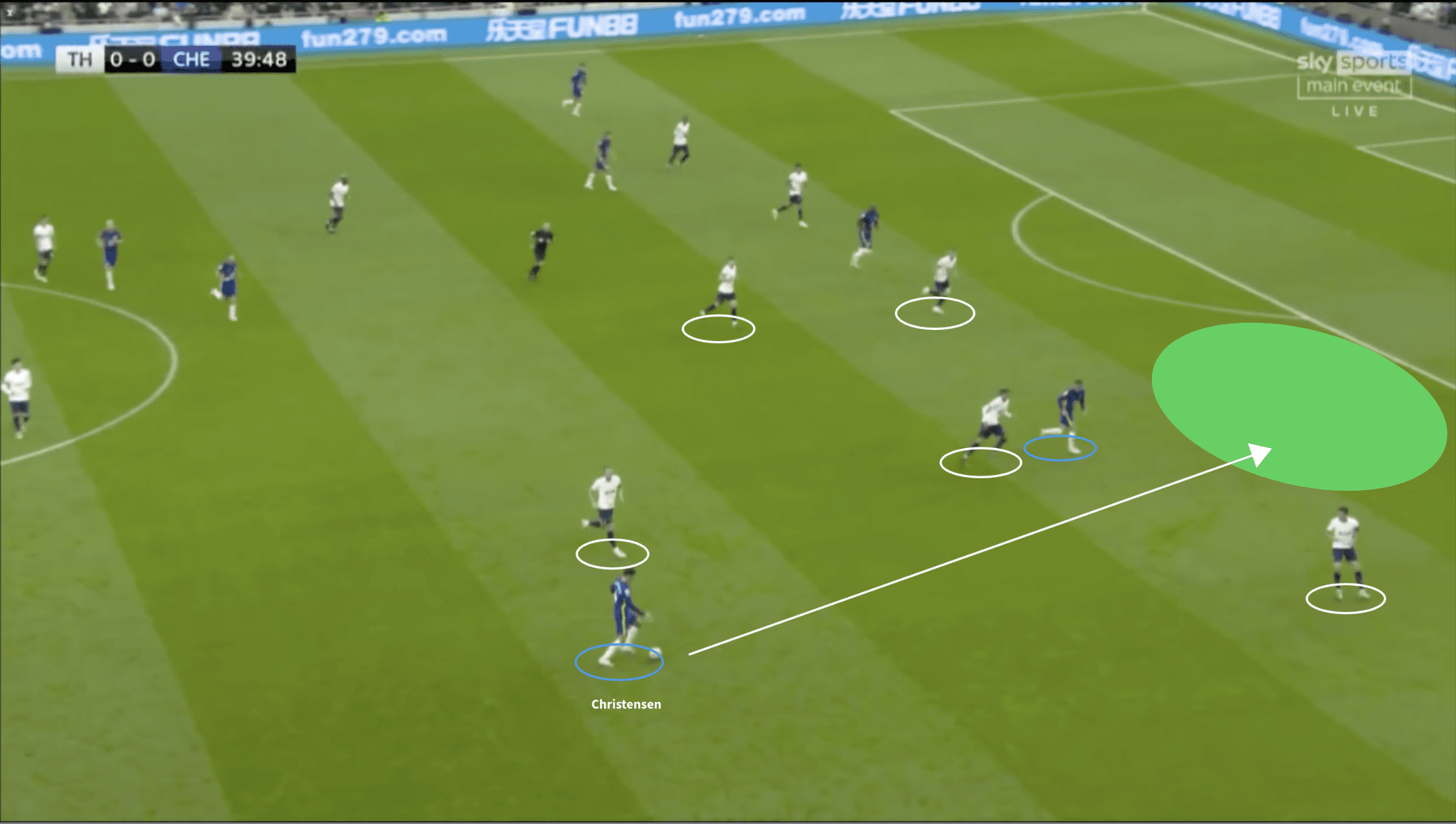
Christensen drives forward into this space, attracting engagement from the Tottenham backline, some of whom have drifted out of position to restrict the amount of space in front of him. This generates space behind the defence that Christensen, again ignoring a simple passing option to the RWB (out of frame), exploits by completing a through-ball into the penalty area.
By driving forward and forcing opponents to close you down, this will naturally increase the space for teammates to receive the ball in other pockets and additionally alters the angles with which to pass into. Christensen’s movement on the ball facilitates these angles and manipulates the opposition’s structure, which increases the effectiveness of the resulting pass.
The general parameters for assessing a player’s efficiency and ability involve evaluating the result of the player’s actions; does the player create better situations? Are the sub-phase conditions for his team better before his actions, or after? Good players consistently create better situations from static possession, which Christensen in these examples displays comfort in performing.
Conclusion
The upcoming summer transfer window represents a defining period for both Chelsea and Barcelona, as both look to rebuild from different forms of on-field and off-field adversity. Whilst most media coverage seems to gravitate around the future of Antonio Rüdiger, Chelsea will contentiously lose a more valuable asset if Andreas Christensen, four years Rüdiger’s junior, makes the move to the Catalan giants.
Christensen possesses as astute tactical knowledge and defensive judgment as any other centre-back his age in the world at the moment. His performances for Chelsea tend to go under the radar because of the way he methodically and steadily defends, as opposed to flying into challenges and rousing the crowd.
This analysis has demonstrated the additional technical and mental attributes needed to be an elite ball-playing defender; an increasingly demanding role that necessitates an extensive and diverse skillset. Christensen assumes the role fantastically for this current Chelsea side and would absolutely fit the build-up passing sequences Xavi has installed in his invigorated Barcelona team. A free transfer for the Dane’s services could end up being one of the deals of the summer.





Comments